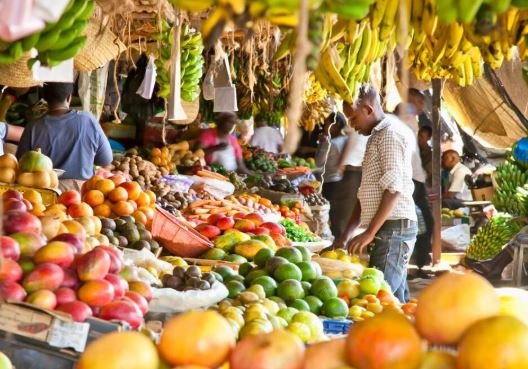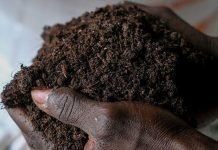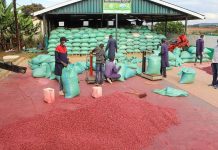AfricaPress-Kenya: Amid locusts infestations and floods, the government has made budget cuts on agriculture, exposing millions to starvation.
This comes while the sector is reeling from losses caused by the global outbreak of the coronavirus pandemic.According to the budget estimates for the 2020-21 financial year, the agricultural sector has been allocated Sh48.7 billion. In the 2019-20 financial year, Treasury allocated Sh59.6 billion to the sector, 18 per cent higher than the allocation made in this year’s budget.
Of the Sh48.7 billion, Sh41 billion will go to the State Department for Crop Development and Agricultural Research and another Sh6.9 billion to the State Department for Fisheries Aquaculture and the Blue Economy.
Treasury Cabinet Secretary Ukur Yatani also said the government has increased allocations to cushion small-scale farmers and horticulture exporters from climate shocks and the effects of the global coronavirus pandemic. “I have set aside Sh3 billion to subsidise the supply of farm inputs through the e-voucher system, which will reach 200,000 small-scale farmers,” he said.
Measly allocation
“I have also allocated Sh3.4 billion for expanded community household irrigation, which will cushion farmers from the adverse effects of weather and further secure food supply chains.”
An additional Sh1.5 billion has been set aside for flower and horticultural farmers to access international markets.However, analysts say these allocations fall short of meeting the resources required to deliver food security targets nationwide, create jobs and save millions currently facing hunger.
According to a report by Route to Food, a non-governmental lobby that advocates for increased government funding to the sector, the allocation to agriculture consistently falls short of requirements. “Budgetary allocations to agriculture are low and continue to decline,” said the lobby group in a report released yesterday.“The sector allocation is low against the required budget of Sh97.7 billion and therefore slashed by 46 per cent.”
According to the report, growth in budget allocations to the agricultural sector over the past five years has not kept pace with growth in allocations to other sectors, raising questions over the government’s commitment to its own food security agenda. “With this measly allocation, compounded by the economic shocks facing the country and the world this year, we can expect an exacerbation of food and nutrition insecurity,” said the report.
Minimum needs
According to the Famine Early Warning System Network (Fews NET), the effects of the spread of Covid-19 and heavy rains have pushed more households to food insecurity and eroded earnings for farmers and workers in the sector. ”Poor urban households which depend on casual wage labour or work in the formal sector continue to face difficulty purchasing their minimum food needs due to the impact of Covid-19 movement restrictions on economic activity,” said Fews NET in its report released last month.
“In some rural areas, recent floods, localised market closures, slowness in food supply chains resulting in high prices and the absence of school meals are negatively affecting household food access,” said the agency in its report. At the same time, data indicates that cumulative rainfall for March to May hit between 120 to 200 per cent, causing major flooding.
“Localised areas of Turkana, Wajir, Isiolo, Laikipia, Kwale, Kitui and Tana River have received 200-400 per cent of average rainfall,” said the report in part.“Recent heavy rains led to floods in 36 counties, where over 800,000 people were affected, including 237 fatalities and over 116,000 displaced.” The floods also led to loss of agricultural output and disrupted value chains with the worst affected areas being Tana River, Mandera, Marsabit and Turkana.
In addition to the threat from flooding, the sector has suffered the brunt of the global spread of the coronavirus pandemic with the depressed demand of Kenyan products in western markets. A report by global consultancy McKinsey Group indicates how the informal nature of Kenya’s local agricultural value chains have helped the market adapt to the disruption from coronavirus, keeping prices steady.
“In Kenya, of 45 major food markets surveyed at the end of April, 90 per cent were open (with the 10 per cent closed being relocated to open-air locations),” states the consultancy in its report released last week.“In some cases, local traders have had to shift their models. For example, livestock trading in Uganda and Kenya has largely moved out of large markets and to on-far sales.” McKinsey, however, said lower-income households will be forced to cut on their budgets as a result of reduced income, deepening food insecurity.
“Given that lower-income households often spend 60 to 80 per cent of their incomes on food, even a moderate reduction in income could lead to nutritional problems like skipping meals, reducing caloric intake or switching to less nutritious (but cheaper) foods,” said the report.
Severe blow
At the same time, producers and exporters of cash crops are also counting billions in losses owing to lockdowns and closures of coffee shops and restaurants in global markets. “Around 80 per cent of agricultural exports from Africa are to four regions: Western Europe, South and East Asia, the Middle East and North America,” explains McKinsey in its report in part.
“Based on 2015-18 averages, those exports are valued at some $35 billion (Sh3.5 trillion) to USD$40 billion (Sh4 trillion) a year.”The report says this could result in a severe economic blow for countries such as Cote d’Ivoire, Ethiopia, Ghana, Kenya, Tanzania and Uganda – all of which rely on these exports as their primary or secondary source of export earnings. This threatens to worsen fortunes for the sector that was already struggling from declining growth.
According to data from the Kenya National Bureau of Statistics, the sector recorded a decreased growth of 3.2 per cent in the third quarter of 2019 compared to a growth of 6.9 per cent in a similar quarter of 2018. This brought down the sector’s contribution to Gross Domestic Product (GDP) to 0.6 per cent in the third quarter of 2019 compared to 1.3 per cent in the same period in 2018. With the sector’s contribution to GDP standing at 31.3 per cent (equivalent to Sh2.209 trillion), this translates to more than Sh72 billion in value lost in just one year.






